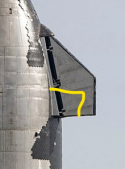That flight was truly epic, we see great iteration testing but changes will need to be sorted up before next flight.
You are using an out of date browser. It may not display this or other websites correctly.
You should upgrade or use an alternative browser.
You should upgrade or use an alternative browser.
NASA & World Space Exploration...News, Views, Photos & videos
- Thread starter bd popeye
- Start date
First of all, there is no wings but flaps. Secondly, how could "wing"/flap super structure being intact and at the same time being damaged?Yeah, that wasn't even the worst of it! but from what you could see the wing super structure looked to be intact? I am not sure if footage of that exists or if they will attempt to recover the starship from the ocean?
Footage of the successful soft landing. You can really see the damage to the flap here, but amazingly the control surface still seems to be functioning.
The final image

It coresponds to this chunk of the flap. About one third of the flap was melt away.

Certainly not!The question is, will Starship be human-rated by 2026, the year of Artemis' manned lunar landing?
Certainly not!
Exactly! They still have to get the heat shield to work properly and who even knows if that is possible with the current Starship design. I do wonder if they will eventually fall back on the booster and use a more traditional second stage. Certainly the booster stage would provide them with a viable base for lunar missions if Starship doesn't work out?
The heatshield is not a problem for the Starship HLS that is to be used by the Artemis program, as Starship HLS is only for landing on the moon and astronauts will return to Earth using Orion.Exactly! They still have to get the heat shield to work properly and who even knows if that is possible with the current Starship design. I do wonder if they will eventually fall back on the booster and use a more traditional second stage. Certainly the booster stage would provide them with a viable base for lunar missions if Starship doesn't work out?
However, Starship HLS needs to be refueled while in LEO ~15 times using other Starship launches. Those ~15 refueling launches will only be economical / practical after Starship becomes fully reusable.
It's more like 30 times. NASA would surely not allow an Orion crew to get inside a HLS and land on the lunar surface on the very first fully fuelled HLS. SpaceX would need to demo landing and return to lunar orbit at least once.The heatshield is not a problem for the Starship HLS that is to be used by the Artemis program, as Starship HLS is only for landing on the moon and astronauts will return to Earth using Orion.
However, Starship HLS needs to be refueled while in LEO ~15 times using other Starship launches. Those ~15 refueling launches will only be economical / practical after Starship becomes fully reusable.
I think it will end up to be a lot more than 30 because of SpaceX's "agile" design and development philosophy. This workflow might work in less critical projects but when we are talking about carrying living payloads, how do they know at which iteration their machinery will be 99.99% assured to preserve human life. They will use up 15 launches for each failed attempt to land and lift off perfectly from the lunar surface with uninterrupted life support throughout.It's more like 30 times. NASA would surely not allow an Orion crew to get inside a HLS and land on the lunar surface on the very first fully fuelled HLS. SpaceX would need to demo landing and return to lunar orbit at least once.
Interesting article that attempts to model out the costs of Falcon rockets.
Much more in the article linked above.
In 2024, the reusability model is vastly improved, and many analysts believe that the possibility that the full cost of each Falcon 9 launch —– including workforce for transport, refurbishment, assembly and operations, depreciation and amortization on facilities (launch sites, factories, test benches) and reusable items (fairings and boosters) — is . While some analysts make implicit assumptions that the full cost of Falcon 9 could be , Eurospace prefers to stay with the more conservative assumption of $28 million per launch.
In the Eurospace model, the assumption set leading to Starlink profitability in 2023 is intimately tied to the assumption of a Starlink Capex under $50 million per launch (satellites included), implying a full cost of a Falcon 9 launch below $30 million. For instance, if the Starlink Capex per launch were only as high as $60 million per launch, total Capex by end 2024 would be $24 billion. Such Capex would imply unsustainable D&A and vastly negative EBIT for the Starlink system alone. If this was the case, SpaceX would probably have had to secure more equity or debt financing to bridge the financial gap. This reverse reasoning is the strongest hint that indeed, for its Starlink system, SpaceX has achieved a capital efficiency never achieved by commercial constellations before, and 70% of that capital efficiency hinges on the low cost of Falcon 9 launches that SpaceX is charging to Starlink.
Much more in the article linked above.


